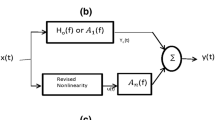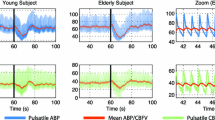Abstract
The clinical importance of cerebral autoregulation has resulted in a significant body of literature that attempts both to model the underlying physiological processes and to estimate the mathematical relationships between clinically measurable variables, the most common of which are Arterial Blood Pressure and Cerebral Blood Flow Velocity. These approaches have, however, rarely been used together to interpret clinical data. A simple model of cerebral autoregulation is thus proposed here, based on a flow dependent feedback mechanism with gain and time constant that adjusts arterial compliance. Analysis of this model shows that it closely approximates a second order system for typical values of physiological parameters. The model parameters can be optimally estimated from available experimental data for the Impulse Response (IR), yielding physiologically reasonable values, although there is one free parameter that must be fixed. The effects of changes in feedback gain and time constant are found to be significant on the predicted IR and can thus be estimated robustly from experimental data. The effects of elevated baseline Intracranial Pressure (ICP) are found to be exactly equivalent to a reduced feedback gain, although the solution is much less sensitive to the former effect. A transfer function approach can be used to estimate autoregulation status clinically using a physiologically-based model, thus providing greater insight into the processes that govern cerebral autoregulation.







Similar content being viewed by others
REFERENCES
Blaber, A. P., R. L. Bondar, F. Stein, P. T. Dunphy, P. Moradshahi, M. S. Kassam, and R. Freeman. Transfer function analysis of cerebral autoregulation dynamics in autonomic failure patients. Stroke 28:1686–1692, 1997.
Carey, B. J., P. J. Eames, M. J. Blake, R. B. Panerai, and J. F. Potter. Dynamic cerebral autoregulation is unaffected by aging. Stroke 31:2895–2900, 2000.
Carey, B. J., B. N. Manktelow, R. B. Panerai, and J. F. Potter. Cerebral autoregulatory responses to head-up tilt in normal subjects and patients with recurrent vasovagal syncope. Circulation 104:898–902, 2001.
Chiu, C.-C., and S.-J. Yeh. Assessment of cerebral autoregulation using time-domain cross-correlation analysis. Comp. Bio. Med. 31:471–480, 2001.
Chon, K. H., Y.-M. Chen, N.-H. Holstein-Rathlou, and V. Z. Marmarelis. Nonlinear system analysis of renal autoregulation in normotensive and hypertensive rats. IEEE Trans. Biomed. Eng. 45:342–353, 1998.
Czosnyka, M., S. Piechnik, H. K. Richards, P. Kirkpatrick, P. Smielewski, and J. D. Pickard. Contribution of mathematical modeling to the interpretation of bedside tests of cerebrovascular autoregulation. J. Neurol. Neurosurg. Psychiatry 63:721–731, 1997.
Dorf, R. C., and R. H. Bishop. Modern Control Systems. Prentice-Hall, 2000.
Eames, P. J., M. J. Blake, S. L. Dawson, R. B. Panerai, and J. F. Potter. Dynamic cerebral autoregulation and beat to beat blood pressure control are impaired in acute ischaemic stroke. J. Neurol. Neurosurg. Psychiatry 72:467–473, 2002.
Giller, C. A., and M. Mueller. Linearity and non-linearity in cerebral haemodynamics. Med. Eng. Phys. 25:633–646, 2003.
Kirkham, S. K., R. E. Craine, and A. A. Birch. A new mathematical model of dynamic cerebral autoregulation based on a flow dependent feedback mechanism. Physiol. Meas. 22:461–473, 2001.
Lee, S. P., T. Q. Duong, G. Yang, C. Iadecola, and S. G. Kim. Relative changes of cerebral arterial and venous blood volumes during increased cerebral blood flow: Implications for BOLD fMRI. Magn. Reson. Med. 45:791–800, 2001.
Liu, Y., A. A. Birch, and R. Allen. Dynamic cerebral autoregulation assessment using an ARX model:comparative study using step response and phase shift analysis. Med. Eng. Phys. 25:647–653, 2003.
Mitsis, G. D., and V. Z. Marmarelis. Modeling of nonlinear physiological systems with fast and slow dynamics: I. Methodology. Ann. Biomed. Eng. 30:272–281, 2002a.
Mitsis, G. D., R. Zhang, B. D. Levine, and V. Z. Marmarelis. Modeling of nonlinear physiological systems with fast and slow dynamics: II. Application to cerebral autoregulation. Ann. Biomed. Eng. 30:555–565, 2002b.
Myers, C. W., M. A. Cohen, D. L. Eckberg, and J. A. Taylor. A model for the genesis of arterial pressure Mayer waves from heart rate and sympathetic activity. Auton. Neurosci. 91:62–75, 2001.
Narayanan, K., J. J. Collins, J. Hamner, S. Mukai, and L. A. Lipsitz. Predicting cerebral blood flow response to orthostatic stress from resting dynamics: Effects of healthy aging. Am. J. Physiol. 281:R716–722, 2001.
Olufsen, M. S., A. Nadim, and L. A. Lipsitz. Dynamics of cerebral blood flow regulation explained using a lumped parameter model. Am. J. Physiol. 282:R611–622, 2002.
Panerai, R. B. System identification of human cerebral blood flow regulatory mechanisms. Cardiovascular Eng. 4:59–71, 2004.
Panerai, R. B., S. L. Dawson, and J. F. Potter. Linear and nonlinear analysis of human dynamic cerebral autoregulation. Am. J. Physiol. 277:H1089–H1099, 1999.
Panerai, R. B., D. M. Simpson, S. T. Deverson, P. Mahony, P. Hayes, and D. H. Evans. Multivariate dynamic analysis of cerebral blood flow regulation in humans. IEEE Trans. Biomed. Eng. 47:419–423, 2000.
Panerai, R. B., S. L. Dawson, P. J. Eames, and J. F. Potter. Cerebral blood flow velocity response to induced and spontaneous sudden changes in arterial blood pressure. Am. J. Physiol. 280:H2162–H2174, 2001.
Panerai, R. B., P. J. Eames, and J. F. Potter. Variability of time-domain indices of dynamic cerebral autoregulation. Physiol. Meas. 24:367–381, 2003.
Reinhard, M., T. Muller, B. Guschlbauer, J. Timmer, and A. Hetzel. Transfer function analysis for clinical evaluation of dynamic cerebral autoregulation—a comparison between spontaneous and respiratory-induced oscillations. Physiol. Meas. 24:27–43, 2003.
Schondorf, R., R. Stein, R. Roberts, J. Benoit, and W. Cupples. Dynamic cerebral autoregulation is preserved in neurally mediated syncope. J. Appl. Physiol. 91:2493–2502, 2001.
Tiecks, F. P., A. M. Lam, R. Aaslid, and D. W. Newell. Comparison of static and dynamic cerebral autoregulation measurements. Stroke 26:1014–1019, 1995.
Ursino, M., and M. Giulioni. Quantitative assessment of cerebral autoregulation from transcranial Doppler pulsatility: A computer simulation study. Med. Eng. Phys. 25:655–666, 2003.
Ursino, M., and C. A. Lodi. A simple mathematical model of the interaction between intracranial pressure and cerebral hemodynamics. J. Appl. Physiol. 82:1256–1269, 1997.
Ursino, M., and C. A. Lodi. Interaction among autoregulation, CO2 reactivity, and intracranial pressure: a mathematical model. Am. J. Physiol. 274:H1715–H1728, 1998.
Ursino, M., A. Ter Minassian, C. A. Lodi, and L. Beydon. Cerebral hemodynamics during arterial and CO2 pressure changes: in vivo prediction by a mathematical model. Am. J. Physiol. 279:H2439–2455, 2000.
Vespa, P. What is the optimal threshold for cerebral perfusion pressure following traumatic brain injury? Neurosurg. Focus 15:Article 4, 2003.
Zhang, R., J. H. Zuckerman, C. A. Giller, and B. D. Levine. Transfer function analysis of dynamic cerebral autoregulation in humans. Am. J. Physiol. 274:H233–H241, 1998.
Zhang, R., J. H. Zuckerman, and B. D. Levine. Spontaneous fluctuations in cerebral blood flow: insights from extended-duration recordings in humans. Am. J. Physiol. 278:H1848–H1855, 2000.
ACKNOWLEDGMENTS
Stephen Payne was funded by the UK Research Councils Inter-Disciplinary Research Consortium (IRC) ‘Medical Images and Signals.’ Thanks are due to the other members of the IRC for profitable discussions and to the two anonymous reviewers for helpful suggestions.
Author information
Authors and Affiliations
APPENDIX
APPENDIX
To derive the linear transfer function, small changes about the basal conditions are assumed using a Taylor series expansion. Since the resulting equations will all be linear, the Laplace transform is used to convert the differential equations into a transfer function.
Equation (2) becomes:
Equation (3) becomes:
Equations (4) and (7) combine to give:
Equation (6) becomes:
Equations (8) and (10) combine to give:
Equation (9) becomes:
The six Eqs. (A1)/(A6), can be used to eliminate the unwanted variables \(\left( {\Delta V_{{\rm sa}}, \,\Delta R_{{\rm sa}}, \,\Delta C_a, \,\Delta p_1, \,\Delta p_2 } \right)\) to derive the expression in Eq. (11). The transfer function for V MCA can be found from the flow rate:
Hence for small changes:
since area is assumed constant. This can then be calculated from the expressions in Eqs. (27)–(32).
Rights and permissions
About this article
Cite this article
Payne, S.J., Tarassenko, L. Combined Transfer Function Analysis and Modelling of Cerebral Autoregulation. Ann Biomed Eng 34, 847–858 (2006). https://doi.org/10.1007/s10439-006-9114-8
Received:
Accepted:
Published:
Issue Date:
DOI: https://doi.org/10.1007/s10439-006-9114-8




